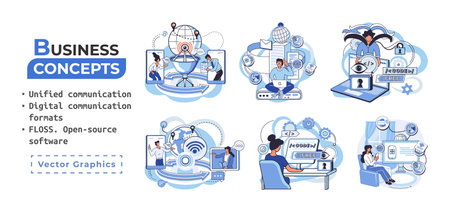Understanding High-Demand Industries in the U.S.
Before making a successful career transition, it’s critical to understand what defines a high-demand industry in the American job market. Generally, these sectors are characterized by rapid job growth, competitive salaries, and long-term stability. High-demand industries often reflect broader economic trends such as technological advancement, demographic changes, or shifts in consumer behavior. In the U.S., factors like digital transformation, aging populations, and environmental concerns have all contributed to shaping which sectors are currently booming.
Key Characteristics of High-Demand Industries
| Characteristic | Description |
|---|---|
| Growth Rate | Sectors with a consistently increasing number of job openings |
| Stability | Industries less likely to be affected by automation or outsourcing |
| Skill Gap | Fields where employers struggle to find qualified candidates |
| Competitive Compensation | Roles offering above-average salaries and benefits |
Current High-Growth Sectors in the United States (2024)
| Industry Sector | Examples of Roles | Why It’s in Demand |
|---|---|---|
| Technology & IT | Software Developer, Cybersecurity Analyst, Data Scientist | Digital transformation across all industries; high need for innovation and security |
| Healthcare & Life Sciences | Nurse Practitioner, Medical Technologist, Physical Therapist | Aging population and increased focus on health outcomes |
| Renewable Energy & Sustainability | Solar Installer, Environmental Engineer, Sustainability Consultant | Government policies and consumer demand for clean energy solutions |
| Logistics & Supply Chain Management | Supply Chain Analyst, Logistics Coordinator, Operations Manager | E-commerce growth and global supply chain optimization needs post-pandemic |
| Financial Services & Fintech | Financial Analyst, Compliance Officer, Blockchain Developer | Diversification of financial products and services; integration of technology into finance |
| Education Technology (EdTech) | E-learning Specialist, Instructional Designer, Education Consultant | Pandemic-driven remote learning trends and ongoing digital adoption in education |
The Bottom Line: Opportunities Across Sectors
No matter your background, understanding which industries are growing helps you target your reskilling and networking efforts effectively. Focusing on sectors with strong demand increases your chances of landing a rewarding position and building a future-proof career.
2. Identifying and Acquiring In-Demand Skills
Successfully transitioning into a high-demand industry in the U.S. starts with identifying which skills are most sought after by employers. Begin by researching current job postings on platforms like LinkedIn, Indeed, or Glassdoor to analyze common requirements and spot skill gaps between your background and your target roles. Pay special attention to both technical skills (such as data analysis, cloud computing, or digital marketing) and soft skills (such as communication, adaptability, or problem-solving).
Researching Skill Gaps
Compare your current skill set with industry expectations. Use informational interviews with professionals already working in your desired field, participate in relevant webinars, and join industry forums to gather firsthand insights. This approach helps you identify not only the must-have qualifications but also emerging trends that can give you a competitive edge.
Selecting Relevant Reskilling Programs
Once youve pinpointed the necessary skills, choose reskilling programs that align with both your career goals and the specific demands of your chosen industry. Consider flexible learning options such as bootcamps, online courses, community college certificates, or even micro-credentials that fit your schedule and budget.
Top U.S. Education & Certification Platforms
| Platform | Focus Areas | Notable Features |
|---|---|---|
| Coursera | Data Science, Business, Tech | University-affiliated certificates; self-paced |
| edX | IT, Project Management, Healthcare | Professional certifications; flexible start dates |
| Udemy | Coding, Marketing, Design | Low-cost courses; user ratings for quality control |
| LinkedIn Learning | Soft Skills, Business Tools | Integration with LinkedIn profile; bite-sized lessons |
| CompTIA/Google Certificates | IT Support, Cybersecurity | Industry-recognized credentials; career support resources |
Tips for Maximizing Your Investment in Reskilling:
- Pursue programs with practical assignments and real-world projects.
- Select courses or certificates recognized by top U.S. employers in your field.
- Add completed credentials to your resume and LinkedIn profile to showcase your commitment to growth.
- Engage in online communities associated with these platforms for peer support and networking opportunities.
By strategically acquiring in-demand skills through reputable educational resources and actively bridging skill gaps, youll be well-positioned to make a successful transition into a high-demand U.S. industry.

3. Leveraging Transferable Skills
When transitioning into a high-demand industry, one of your most powerful assets is your set of transferable skills. These are competencies and experiences youve gained in previous roles that can be applied to new positions—even if they’re in entirely different fields. U.S. employers highly value candidates who can effectively communicate how their existing skills align with the demands of a new industry. Understanding how to identify, articulate, and showcase these transferable skills will set you apart during your job search.
Recognizing Your Transferable Skills
Begin by assessing your current skillset. Consider both hard and soft skills, such as project management, communication, problem-solving, data analysis, leadership, or customer service. Ask yourself: Which tasks did I consistently excel at? What positive feedback have I received from managers or peers? Which parts of my job did I enjoy most?
Examples of Transferable Skills and Their Applications
| Current Skill | Description | How It Applies to a New Industry |
|---|---|---|
| Project Management | Coordinating tasks, managing deadlines, leading teams | Valuable for tech, healthcare, and logistics roles needing organized workflow and leadership |
| Customer Service | Resolving issues, active listening, empathy | Useful in sales, client relations, HR, and user experience roles across industries |
| Data Analysis | Interpreting trends, making data-driven decisions | Sought after in marketing analytics, finance, and IT positions |
| Public Speaking | Presenting ideas clearly to groups or stakeholders | Essential for training roles, sales pitches, or team leadership positions |
| Adaptability | Thriving in changing environments or learning new systems quickly | Cherished in startups, tech companies, and any fast-paced sector |
Presenting Your Skills to U.S. Employers
When updating your resume or LinkedIn profile for an American audience, use language that mirrors the terminology found in job postings for your target industry. Replace internal company jargon with industry-standard terms. For instance, instead of saying “handled guest complaints,” say “managed customer escalations to deliver positive resolutions.” Quantify achievements where possible (“Reduced processing time by 20% through streamlined workflows”). In interviews and networking conversations, share stories that demonstrate your skills in action—use the STAR method (Situation, Task, Action, Result) to frame your examples.
Key Takeaway:
The ability to recognize and market your transferable skills—using clear language and relevant examples—can help bridge the gap between your past experience and future opportunities in high-demand U.S. industries.
4. Building and Activating Your Network
Networking is a key pillar in any successful career transition, especially when breaking into a high-demand industry in the United States. Understanding American networking norms will help you make genuine connections and open doors to new opportunities. Here’s how to navigate both digital and face-to-face networking environments effectively.
Understanding American Networking Culture
In the U.S., networking is often about building authentic professional relationships rather than just collecting contacts. People appreciate sincerity and mutual value exchange, so focus on what you can offer as well as what you hope to gain. Small talk is common at the start of conversations, and following up with a personalized thank-you note or message is considered good etiquette.
Effective Approaches on LinkedIn
LinkedIn is the primary platform for professional networking in America. Your profile should be up-to-date, featuring a clear headline, professional photo, and detailed work history. When reaching out to new contacts, personalize your connection requests—mention shared interests or explain why you’d like to connect.
| Action | Best Practice |
|---|---|
| Connection Requests | Add a short, specific note (e.g., “I enjoyed your recent post on industry trends.”) |
| Engaging Content | Share insights or articles relevant to your target industry to show expertise |
| Messaging | Be concise, polite, and always thank others for their time or advice |
Maximizing Industry Events and Meetups
Attending conferences, seminars, and local meetups offers invaluable face-to-face networking opportunities. Prepare a brief self-introduction (“elevator pitch”) that highlights your background and your interest in the industry. Don’t hesitate to ask questions about other people’s roles or experiences—Americans generally appreciate curiosity and initiative.
Tips for Genuine Connections at Events:
- Listen actively: Show genuine interest by asking follow-up questions.
- Exchange business cards: This is still common practice at many events.
- Follow up promptly: Send a LinkedIn invite or email within 24-48 hours referencing your conversation.
The Power of Giving Back
One of the most respected ways to build your network in the U.S. is by helping others without expecting immediate returns. Offer introductions, share useful resources, or volunteer at industry functions—you’ll quickly gain a reputation as a valued community member. Remember, strong networks are built on trust and reciprocity.
5. Crafting an Industry-Focused Resume and Personal Brand
Breaking into a high-demand industry in the U.S. requires more than just acquiring new skills—it’s about presenting yourself as the ideal candidate through a tailored resume and a strong personal brand. Here are actionable strategies for optimizing your application materials and digital presence to resonate with American employers.
Tailor Your Resume for the Target Industry
Your resume should be customized to align with the specific requirements of your desired industry. Highlight transferable skills, relevant certifications, and quantifiable achievements that directly relate to the roles you’re pursuing. Use industry-specific keywords that are commonly found in U.S. job descriptions to help your resume pass Applicant Tracking Systems (ATS).
| Resume Section | What to Emphasize |
|---|---|
| Professional Summary | Concise statement focusing on relevant experience and career goals tailored to the target industry. |
| Skills | Highlight both technical and soft skills sought after in the industry. |
| Experience | Quantify results (e.g., “Increased sales by 25%”) and focus on accomplishments over duties. |
| Certifications/Education | Include any recent training or certifications related to the new field. |
Optimize Your LinkedIn Profile
Your LinkedIn profile is often the first impression you make on recruiters in the U.S. Ensure your headline reflects your target role, update your summary to include industry-specific aspirations, and showcase projects or portfolios relevant to your new career path. Don’t forget to request recommendations from colleagues or mentors who can speak to your adaptability and skillset.
Key LinkedIn Optimization Tips:
- Headline: Use job titles and keywords relevant to your desired industry.
- About Section: Tell a compelling story about your transition, focusing on motivation and unique strengths.
- Featured Section: Add links to work samples, certifications, or articles showcasing expertise.
- Skills & Endorsements: Prioritize skills aligned with high-demand roles; seek endorsements from peers.
Communicate Your Unique Value Proposition (UVP)
American employers value candidates who clearly articulate what sets them apart. Develop a UVP statement that combines your background, reskilled abilities, and passion for the new industry. Incorporate this narrative into your resume, cover letter, LinkedIn profile, and networking conversations.
Example of a UVP Statement:
“With a proven track record in project management and newly acquired data analytics expertise, I bring a unique blend of leadership and technical insight to drive impactful business solutions in the technology sector.”
By strategically tailoring your resume, building an engaging LinkedIn presence, and communicating your distinctive strengths, you’ll stand out as a highly adaptable candidate ready for success in America’s most competitive industries.
6. Navigating the Interview Process and Onboarding
Once you’ve built the right skills and networked your way into interviews, it’s crucial to understand the unique expectations of American employers during the hiring process. Mastering the interview and onboarding stages can be your gateway to long-term success in a high-demand industry.
Understanding American Interview Expectations
In the U.S., interviews often focus not only on technical abilities but also on soft skills, cultural fit, and problem-solving approaches. Employers value candidates who demonstrate initiative, adaptability, and strong communication.
| Expectation | What It Means | How to Demonstrate |
|---|---|---|
| Punctuality | Arriving early shows professionalism | Log in 5-10 minutes early for virtual interviews |
| STAR Method Responses | Structured answers to behavioral questions | Use Situation, Task, Action, Result framework |
| Cultural Fit | Alignment with company values | Research company culture; reference shared values in answers |
| Follow-Up Etiquette | Sending thank-you notes post-interview | Email a concise thank-you within 24 hours |
Common Behavioral Interview Questions
American interviews frequently include behavioral questions designed to assess how you’ve handled situations in the past. Here are examples and tips for answering them:
- “Tell me about a time you faced a challenge at work.”
Describe the situation, your approach, and what you learned. - “Give an example of how you worked on a team.”
Highlight communication skills and collaboration. - “Describe a situation where you had to quickly learn something new.”
Mention adaptability and eagerness to upskill—crucial for transitioning industries. - “How do you prioritize tasks when under pressure?”
Showcase organizational skills and decision-making abilities.
Acclimating to New Workplace Cultures Post-Hire
The American workplace often emphasizes open communication, proactive feedback, and diversity. To thrive during onboarding:
- Be Proactive: Introduce yourself to colleagues, ask questions, and seek clarification when needed.
- Understand Communication Styles: Direct communication is common; don’t hesitate to share ideas or concerns respectfully.
- Diversity & Inclusion: Respect varied backgrounds and perspectives—most U.S. companies value inclusive teamwork.
- Continuous Learning: Take advantage of training sessions or mentorship programs offered by your employer.
- Adaptability: Be open to new workflows or technologies that may differ from previous experiences.
Your First 90 Days: Key Milestones for Success
| Timeframe | Main Goals | Tactics |
|---|---|---|
| First Month | Learns systems & builds relationships | Attend orientation, connect with teammates, schedule check-ins with manager |
| Second Month | Takes on initial projects independently | Solve small problems, ask for feedback regularly, join team meetings actively |
| Third Month | Makes visible contributions & adapts fully to culture | Spearhead an initiative or improvement, offer help to others, review performance goals with supervisor |
The Bottom Line: Confidence and Curiosity Win the Day!
Navigating interviews and onboarding can be challenging but rewarding. By preparing for American-style questions, displaying cultural awareness, and taking initiative after hire, you’ll position yourself as a valuable asset in any high-demand industry transition.


